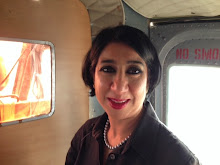Over the past three days, there have been demonstrations and protests by British Tamils, attempting to raise the profile of their civilian counterparts caught up in the ongoing battle between the Sri Lankan Government and the separatist Tamil Tigers, the Liberation Tigers of Tamil Eelam (LTTE) who have been fighting for an independent homeland. The LTTE is banned in Britain, though its distinctive red and yellow flag has been very much in evidence on the marches which at their height numbered 3,000. In Melbourne and Sidney, Australia, 4,000 Tamils converged, and similar events have been taking place sporadically in other cities like Paris and Geneva.
Claiming discrimination at the hands of the Sinhalese - dominated government, the LTTE began to fight for an independent Tamil homeland in the north and east of Sri Lanka in the mid-1980s.
Thousands of Tamils have been displaced during this war. About 800,000 live outside Sri Lanka, with the largest groupings located in the UK and Canada. Talking to Tamil families in London, it is hard to find one without direct experience of a relative being caught up in the conflict. Does anyone ever actually ask them their reasons for forsaking their beautiful homeland?
An estimated 30-35,000 are being held in what Human Rights Watch describes as 'Detention Camps' with reportedly inadequate health and sanitation facilities. The United Nations says that there are still 150,000 Tamils trapped in the war zone in the north. In recent days, there have been unsubstantiated reports of poisonous nerve gas attacks by the Sri Lankan army on civilian Tamils.
The BBC says on its website; 'The United Nations estimates more than 2,800 civilians have been killed and 7,000 others injured in the fighting in the north-east of Sri Lanka in the last two months. The country's government disputes these figures.'
Despite regular statements by the UN's Ban Ki Moon, Britain's Foreign Secretary, David Miliband, other officials and well-meaning charities, a stringent veto on untrammelled media and visitor access applied by the Sri Lankan Government means that the war zones remain sealed off and the outside world has no idea about what is actually happening in the conflict areas.
When I have reported on Tamil areas in Sri Lanka, I have been given first-hand accounts of no electricity available, water in short supply, and a paucity of medicines and pain relief for hospitals. When there is no power for fridges and freezers, food preservation is difficult. With slow and inadequate transport, women told me about giving birth en route to hospital and then a lack of adequate care when they got there so that infections easily took hold-if the infants or their mothers survived. And, with so many husbands, sons and brothers occupied in fighting or lost to the war, there is a plethora of women-headed households now.
On the 1st April 2009, US Secretary of State Hillary Clinton wrote to US Congress members, 'The international community has started planning for the post-conflict period, I emphasized that the Sri Lanka Army should not fire into the areas where civilians are trapped in the conflict zone. I urged President Rajapaksa to devise a political solution to the ongoing conflict.'
Meanwhile, the shooting and the shelling continues. But how many of us really care?
Tuesday, 7 April 2009
Subscribe to:
Post Comments (Atom)


No comments:
Post a Comment